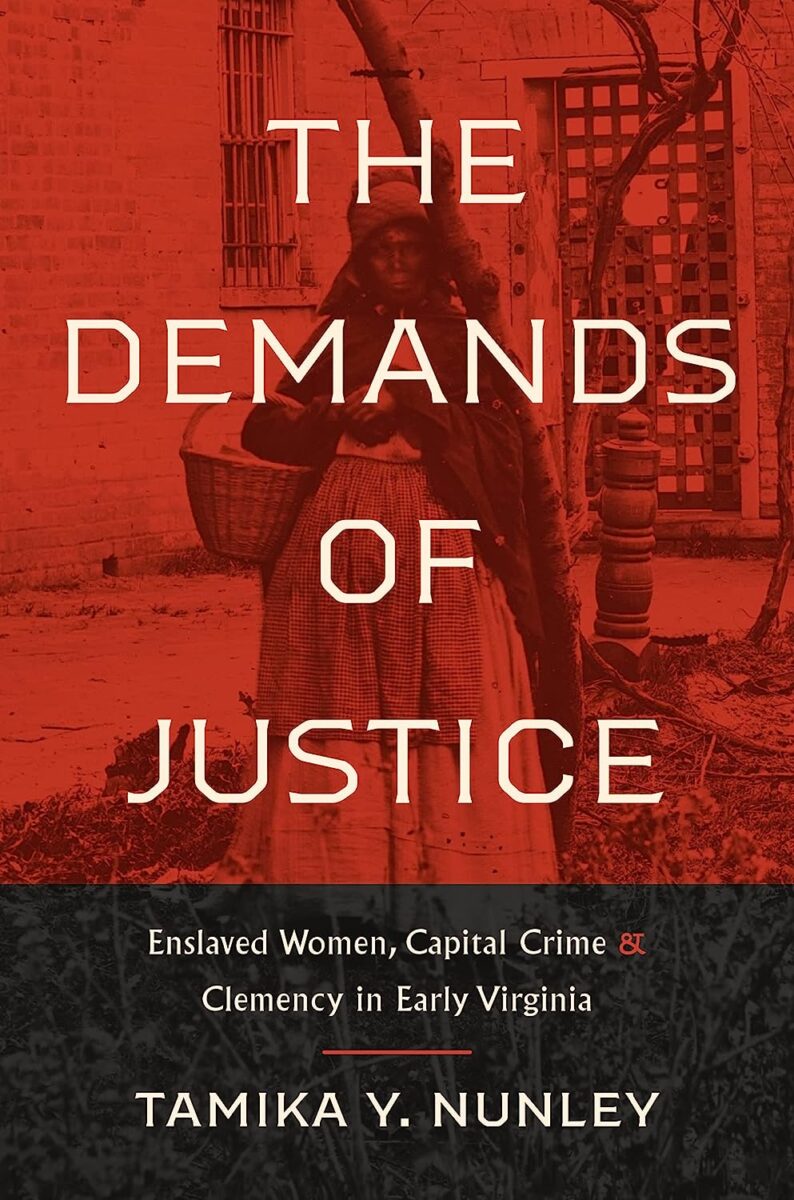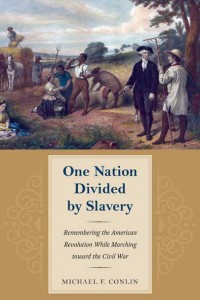The Demands of Justice examines “the lives of enslaved women accused of capital crimes to understand how slavery and its corresponding laws and social customs worked to criminalize them and limit their access to legal justice” (1). Tamika Y. Nunley, currently Associate Professor of History and Sandler Family Faculty Fellow at Cornell University and the author of At the Threshold of Liberty: Women, Slavery, and Shifting Identities in Washington, D.C., poses an important question throughout the book—namely, what did justice and clemency look like under this system?
Nunley makes it clear that she does not romanticize the actions of the enslaved people she studies, and that she does not offer an extended discussion of the nuances of the early legal system. Rather, she analyzes the actions of enslaved women and girls in nineteenth-century Virginia who “found themselves in conflict with white Southerners that began outside of the courts” (2) and, specifically, “what these actions might mean and what they tell us about alternative considerations of justice not yet realized in the legal system but manifested in the decisions of enslaved women and girls” (2).
The legal encounters that appear throughout this book reveal a system that “worked to define and affirm a commitment to legal paternalism, that upheld the rule of law and made slavery viable” (3). But they also illuminate decades of responses by enslaved women. Unlike white people accused of capital crimes, courts did not allow enslaved people to testify against a white person, although they could testify against another enslaved person. Nineteenth century jurists used words like leniency, reprieve, and mercy when they sentenced enslaved people, but clemency differed greatly for enslaved people and white people. White Virginians “did not face the prospect of being sold into lifelong bondage but served sentences at the state penitentiary or brief terms in the local jail or were absolved of their crimes altogether” (8). Enslaved women granted clemency, by contrast, were jailed and sold outside of Virginia. Commutation of sentences saved Virginia money and helped support (in the eyes of some people) the idea that slavery was a benevolent institution. Of course, enslaved women who received so-called clemency and were sentenced to transportation outside of Virginia had a very different perspective about the peculiar institution, as did all other enslaved people. Unlike other books that examine slavery, the law, and the courts, The Demands of Justice does not foreground courts, lawmakers, justice, and laws. Rather, it studies “ideas and actions deemed impalpable because of the ways that enslaved women and girls were criminalized” (14).
Nunley begins by discussing how the ideology of race shaped early Virginia legal culture. White colonists in Virginia “created property regimes that affirmed their entitlement to Native land; the indentures of Natives, émigrés, and Africans; and the perpetual bondage of African-descended people born into slavery” (27). Transatlantic cultural encounters shaped the actions of enslaved women. When Mary Aggie petitioned the court for her freedom, she impressed Governor William Gooch with her testimony about her unwavering faith in God. Several years later, after Aggie was tried and convicted of felonious theft, Gooch argued that she was entitled to benefit of the clergy. The “theological undercurrents that shaped the possibility of mercy,” Nunley notes, “also informed how African-descended women like Aggie acted on established and locally recognized ideas of fairness and evenhandedness” (36).
The following chapters focus on enslaved women accused of poisoning, murder, infanticide, and, lastly, insurrection, theft, escape, attempted murder, and arson. Incidents involving poison “reveal the inner workings of a knowledge war, one in which enslaved women tapped into a pharmacopoeia filled with various intellectual and incorporeal dimensions” (53). The gendered division of labor, as well as “the trust that laboring in the intimate environs of the household implied, meant that women and girls often faced accusations of poisoning” (59). Sentences could and did vary tremendously. Annie, an enslaved woman, was accused of attempting to kill Matthew Allen and his wife after Allen discovered pieces of glass in the food. Annie was convicted and, despite the court’s recommendation of clemency, executed on October 20, 1829. Another enslaved woman named Susan may have mixed poke root (an herb with medicinal properties that increased in toxicity over time) into a meal for Judith Brightwell. The court found Susan guilty and sentenced her to sale and transportation. As Nunley observes, “the outcomes of these cases might point to the kind of evidence found in the food they prepared. Broken glass sends a clearer signal of harm than roots that might be used for either healing or harmful purposes” (71).
Unsurprisingly, Virginia locals “took a collective interest in the court proceedings involving the murder trials of white Southerners and the enslaved women who bore the weight of the accusations against them” (87). White Virginians submitted petitions to the court and frequently weighed in on trials. For example, Nelly, an enslaved woman, her children Betsy and James, and her grandchildren Elias and Ellen were charged with the murder of George E. Green. Nelly, Besty, and James were hanged, but white Virginians were unconvinced that Elias and Ellen deserved the death penalty. They petitioned for a different sentence, and Governor Henry Wise commuted the sentence to transportation. Enslaved women’s violent crimes did not occur frequently. However, when they did, some white people “struggled to come to terms with the ways these acts disrupted their ideas about gender” (102). Agnes was tried for the murder of Gerard Mason, the grandson of George Mason. The testimony taken in the case, however, “placed the spotlight on Mason’s behavior and reputation in ways that contextualized the sexual terror that galvanized enslaved women’s murders of white Southerners” (109). Agnes resisted Mason’s sexual advances, and witness testimony demonstrated that Mason had a penchant for sadistic violence. Petitioners requested that Agnes be sentenced to transportation, not the death penalty. However, “antebellum law did not recognize any acts of attempted or actual rape of an enslaved woman committed by a white person” (111). Agnes was executed and, ultimately, “the legal value of whiteness outweighed the scales of human justice” (112).
Cases involving infanticide “raised a number of questions about what the bodies of the enslaved might tell the court about the cause of death and the parties responsible for any deaths” (116). Sometimes infanticide inspired clemency, as in the case of Lucy, who abandoned her newborn child in the woods. Although there was enough evidence for conviction, the inquest discovered that the child was a mulatto (a term used to describe people of mixed race). This fact, Nunley contends, likely motivated the people who petitioned for a sentence of transportation for Lucy because reputations mattered in antebellum Virginia. On the other hand, there was no petition for clemency when Milly was accused of murdering her child, perhaps because locals may not have had much knowledge about Milly and based their opinions on hearsay. Ultimately, Nunley powerfully concludes, “the actions of these women force us to question the parameters of justice more broadly and the systemic apparatus that makes death, continued bondage, or sale outside of Virginia the best possible outcome. What is clemency in instances where enslaved women decide that death is better than a life in the slave South” (143).
The final chapter in the book considers insurrection, theft, escape, attempted murder, and arson. Enslaved women rebelled against slavery long before the U.S. Civil War began, and their actions “sent rumblings that signaled that the foundations of slave society faced a new enemy within” (144). Jenny was acquitted of burning one of Robert Pickett’s barns, but Adaline, a fifteen-year-old, was found guilty of burning Richard Stonnell’s dwelling and sentenced to fifteen lashes. This sentence was lenient in the sense that adult enslaved people were often sentenced to thirty lashes, but “from the perspective of a young girl, baring her back to be publicly whipped came with a healthy dose of pain and trauma” (157). Here again, readers see another demonstration of what clemency entailed in Virginia. Historians often focus on male enslaved people and their actions during the U.S. Civil War, but enslaved women also leveraged the conditions of war to “abandon farms, burn houses, take food, and begin life anew” (155).
The cases studied in this book, Nunley argues, “reveal more than legal outcomes; they show the violent ruptures, tensions, forced intimacy, and power dynamics that shaped the world that slavery made” (186). The Demands of Justice, by delving into the lives of enslaved women who were accused of capital crimes, poses important questions about the nature of justice and clemency in antebellum Virginia. Anyone who is interested in the history of slavery, race, and gender in the Americas, legal history, or southern history should read this book.
Evan C. Rothera is an Assistant Professor of History at the University of Arkansas—Fort Smith. He is the author of Civil Wars and Reconstructions in the Americas, which was a finalist for the Colby Award.





